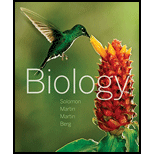
Concept explainers
A symbiotic association in which organisms are beneficial to one another is known as (a) predation (b) interspecific competition (c) intraspecific competition (d) commensalism (e) mutualism
Introduction: Elucidation and inspection of patterns and processes within a community is known as community ecology. Communities contain large number of individuals of different species those interact with each other and are independent in various ways. Every organism mostly plays one of the three important roles of the ecosystem in community life, namely producer, consumer, or decomposer.
Answer to Problem 1TYU
Correct answer: A symbiotic association in which organisms are beneficial to one another is known as mutualism. Hence the correct answer is option (e).
Explanation of Solution
Reason for correct answer:
Option (e) is given as “mutualism”.
The type of symbiosis in which both the specie are benefited by each other is known as mutualism. The relationship is obligatory in which both species need each other for survival. For example, the association between nitrogen-fixing bacteria of the Rhizobium and the plants like beans, peas and clover. Nitrogen fixing bacteria gives the plant nitrogen for the manufacturing of chlorophyll, nucleic acids, and plants and the plant supplies energy-rich organic molecules and sugar.
Hence the correct answer is option (e).
Reasons for incorrect answers:
Option (a) is given as, “predation”. The consumption of one species by another species is known as predation. Hence, option (a) is incorrect.
Option (b) is given as, “interspecific competition”. Competition occurs between members of different species and individuals with several adaptations for survival are known as interspecific competition. Hence, option (b) is incorrect.
Option (c) is given as, “intraspecific competition”. Competition occurs between same species and organisms with similar adaptations for all types of essential requirements are known as intraspecific competition. Hence, option (c) is incorrect.
Option (d) is given as, “commensalism”. The type of symbiosis in which only one species is benefited and other species remain unaffected is known as commensalism. Hence, option (d) is incorrect.
Hence the options (a), (b), (c), and (d) are incorrect.
Mutualism is a symbiotic association in which both organisms are beneficial to one another.
Want to see more full solutions like this?
Chapter 54 Solutions
Biology (MindTap Course List)
Additional Science Textbook Solutions
Biological Science (6th Edition)
Chemistry: Structure and Properties (2nd Edition)
Laboratory Manual For Human Anatomy & Physiology
SEELEY'S ANATOMY+PHYSIOLOGY
Biology: Life on Earth with Physiology (11th Edition)
- Describe the principle of homeostasis.arrow_forwardExplain how the hormones of the glands listed below travel around the body to target organs and tissues : Pituitary gland Hypothalamus Thyroid Parathyroid Adrenal Pineal Pancreas(islets of langerhans) Gonads (testes and ovaries) Placentaarrow_forwardWhat are the functions of the hormones produced in the glands listed below: Pituitary gland Hypothalamus Thyroid Parathyroid Adrenal Pineal Pancreas(islets of langerhans) Gonads (testes and ovaries) Placentaarrow_forward
- Describe the hormones produced in the glands listed below: Pituitary gland Hypothalamus Thyroid Parathyroid Adrenal Pineal Pancreas(islets of langerhans) Gonads (testes and ovaries) Placentaarrow_forwardPlease help me calculate drug dosage from the following information: Patient weight: 35 pounds, so 15.9 kilograms (got this by dividing 35 pounds by 2.2 kilograms) Drug dose: 0.05mg/kg Drug concentration: 2mg/mLarrow_forwardA 25-year-old woman presents to the emergency department with a 2-day history of fever, chills, severe headache, and confusion. She recently returned from a trip to sub-Saharan Africa, where she did not take malaria prophylaxis. On examination, she is febrile (39.8°C/103.6°F) and hypotensive. Laboratory studies reveal hemoglobin of 8.0 g/dL, platelet count of 50,000/μL, and evidence of hemoglobinuria. A peripheral blood smear shows ring forms and banana-shaped gametocytes. Which of the following Plasmodium species is most likely responsible for her severe symptoms? A. Plasmodium vivax B. Plasmodium ovale C. Plasmodium malariae D. Plasmodium falciparumarrow_forward
- please fill in missing parts , thank youarrow_forwardplease draw in the answers, thank youarrow_forwarda. On this first grid, assume that the DNA and RNA templates are read left to right. DNA DNA mRNA codon tRNA anticodon polypeptide _strand strand C с A T G A U G C A TRP b. Now do this AGAIN assuming that the DNA and RNA templates are read right to left. DNA DNA strand strand C mRNA codon tRNA anticodon polypeptide 0 A T G A U G с A TRParrow_forward
 Biology (MindTap Course List)BiologyISBN:9781337392938Author:Eldra Solomon, Charles Martin, Diana W. Martin, Linda R. BergPublisher:Cengage Learning
Biology (MindTap Course List)BiologyISBN:9781337392938Author:Eldra Solomon, Charles Martin, Diana W. Martin, Linda R. BergPublisher:Cengage Learning Concepts of BiologyBiologyISBN:9781938168116Author:Samantha Fowler, Rebecca Roush, James WisePublisher:OpenStax College
Concepts of BiologyBiologyISBN:9781938168116Author:Samantha Fowler, Rebecca Roush, James WisePublisher:OpenStax College Biology Today and Tomorrow without Physiology (Mi...BiologyISBN:9781305117396Author:Cecie Starr, Christine Evers, Lisa StarrPublisher:Cengage Learning
Biology Today and Tomorrow without Physiology (Mi...BiologyISBN:9781305117396Author:Cecie Starr, Christine Evers, Lisa StarrPublisher:Cengage Learning Human Biology (MindTap Course List)BiologyISBN:9781305112100Author:Cecie Starr, Beverly McMillanPublisher:Cengage Learning
Human Biology (MindTap Course List)BiologyISBN:9781305112100Author:Cecie Starr, Beverly McMillanPublisher:Cengage Learning





